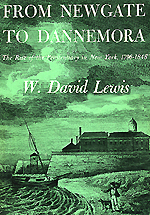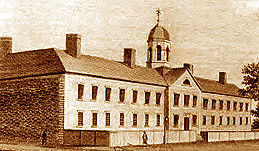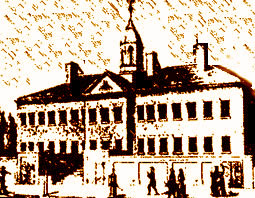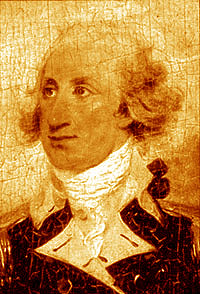xxx

xxx
NYCHS presents excerpts from From Newgate to Dannemora: The Rise of
the Penitentiary in New York, 1796-1848, by W. David Lewis.
Copyright © 1965 by Cornell University; copyright renewed 1993.
Used by permission of the author and the publisher, Cornell
University Press. All rights reserved. Click on image, based on book jacket front cover, to access Cornell University Press site.
|
|
Chapter I: Heritage (Part I)
(Excerpted from Pages 1 through 9)
. . . . No American state was more deeply involved in penal pioneering than New York, which revamped its old methods of punishment in 1796. Led by a Quaker merchant named Thomas Eddy, reformers secured the passage of a law abolishing
the death penalty for all but three crimes and prescribing lengthy
prison sentences for most major offenses.
This action launched New York upon a course of penitentiary management which in time made it the avowed rival of the state from which it had all but copied its first modern penal code -- Pennsylvania . . .
Following the removal of British restraints, Pennsylvania soon became a leader in adopting new methods of dealing with criminals. . . . authorities turned to protracted confinement as a preferable policy. The legislature passed a series of laws prohibiting liquor in jails, establishing separation of the sexes among inmates, appointing official prison inspectors, separating debtors from felons, restricting indiscriminate visiting of jails, and providing solitary confinement for the most hardened offenders.
Capital punishment was again reserved for first degree murder.
The Walnut Street Jail, a Philadelphia institution upon which
construction had been started before the Revolution, now began
receiving felons from all parts of the state.
Applauding these developments, and applying most of the pressure which brought them about, was a group of citizens who in
1787 founded “The Philadelphia Society for Alleviating the
Miseries of Public Prisons,” which has been called “the first of the
great modern prison reform societies.”
xxx
 Walnut St. Jail sketches, above and below, do not appear in From Newgate to Dannemora but do appear on this web site in a NYCHS excerpts presentation of On the Penitentiary System in the U.S. and Its Application in France by Gustave de Beaumont & Alexis de Tocqueville
Clicking either of the two images will access the page where they appear with a descriptive quote about the Walnut St. Jail from the 1949 Handbook of Correctional Institution Design and Construction, United States Bureau of Prisons.
xxx

|
|
Strong support for new
methods came from members of the Society of Friends, reflecting
the Quaker belief that any man - even a criminal - possessed a
share of the divine “inner light” which could be reached and
nurtured through proper treatment. The reform movement, however, was broadly based, enlisting the efforts of such men as
Episcopal Bishop William White and the prominent physician
Benjamin Rush. Inspiration also came from abroad through the
writings of the great English prison reformer John Howard and
the achievements of Sir Thomas Beevor, who had established a
model jail at Wymondham, Norfolk.
Influential citizens in New York observed the correctional reforms in Pennsylvania with interest. Especially conversant with the
new measures was Thomas Eddy, who had been reared in Philadelphia and knew various humanitarians there. As a Tory in the Revolution, Eddy had experienced a brief taste of wretched jail
conditions. As a merchant, he had reason to desire a penal code in
New York which would protect property more effectively than
the ill-assorted and unevenly executed sanguinary punishments
that prevailed there. As a Quaker, he believed that many
criminals could be reformed if subjected to firm but humane
treatment.
Eddy, who eventually came to be known as the “John Howard
of America” . . . was a quiet crusader who knew how to
interest the right people in his ideas and had marked abilities as a
lobbyist. . . . he became well acquainted with General Philip Schuyler, father-
in-law of Alexander Hamilton . . . Keenly aware of the prestige which
the General’s name would bring to the cause of prison reform in
New York, and of the power which Schuyler wielded as a state
senator, Eddy persuaded his friend to visit Philadelphia with him
in the winter of 1796 and inspect the Walnut Street Jail.
Schuyler
was impressed with the institution, and helped Eddy draft a bill
for the establishment of a penitentiary system in New York . . . They arranged to
have Ambrose Spencer, a powerful political leader, introduce the
measure, and Schuyler spoke strongly in its support.
xxx

xxx
The John Howard profile above does not appear in From Newgate to Dannemora but does appear on this web site in a NYCHS excerpts presentation of The History of the Office of Sheriff
by Schenectady County Sheriff Harry C. Buffardi. Clicking the image -- logo of the John Howard Society of Canada -- will access the page about British Sheriff reformer John Howard.
|
|
Eddy played his part during the debates by having copies of
the Pennsylvania penal code distributed freely among the lawmakers and by being present as a lobbyist. When the act was
passed on March 26, 1796, he was placed on a four-man committee empowered to build the state prison and that body in turn gave him primary authority to supervise this task. . . .
.
His theories on the treatment of criminals owed much to
the writings of such men as Howard, Montesquieu, and Beccaria.
The penitentiary which he built in New York showed considerable
European influence, even to the point of being named "Newgate"
after the famous English institution. . . .
[American] prison reformers . . . took it for granted that the felon
offended both man and God, and that the church as a guardian of
moral order and social stability had an important part to play in
the treatment of lawbreakers.
By this time, however, other concepts had also assumed great significance. According to the theory of deterrence, inflicting pain on an offender was justifiable because
it discouraged others from following his example. The idea of
reformation, on the other hand, led many to believe that the
treatment of a criminal, whether painful or otherwise, should
make him a better person.
These two philosophies, not really
antithetical but nevertheless difficult to reconcile in practice, were part of America's intellectual inheritance from the Old World. . . .
Such inflictions as
whipping, maiming, and killing were attractive to law-enforcement
officials not only because they could easily be witnessed by spectators and thus have some deterrent effect, but also because they
were speedy and cheap. Occasionally it was profitable to confine
felons and force them to row galleys, build public works or to
perform various other useful tasks. In other cases, as in ancient
Greece, incarceration became a common alternative punishment
for offenders who could not — or would not — pay fines.
xxx

xxx
The Philip Schuyler portrait above does not appear in From Newgate to Dannemora but is based on one that does appear on the New York State Museum site in the People of Colonial Albany section. Click the image for a Schuyler bio by Stefan Bielinski.
|
|
By and
large, however, the prison as a place of punishment or corrective
treatment is a modern innovation. Until the eighteenth century it
was usually only a place of temporary detention for untried
suspects, political enemies of the state, holders of heterodox religious views, and insolvent debtors.
One important organization, however, did manage to gain considerable experience over the centuries in providing institutional
treatment for convicted offenders. During the Middle Ages the
Roman Catholic Church gained special criminal jurisdiction,
within certain limitations, over clergymen and members of religious orders.
Excessively severe punishments could, and sometimes did, occur under the use of this authority; but the fact that most offenders preferred to be tried by ecclesiastical courts rather
than by civil ones indicates that the penalties inflicted by the
former were usually more lenient than those meted out by the
latter. Because of this relative clemency, the privilege of “benefit
of clergy” became more and more widely sought, and was gradually extended not only to a variety of minor church functionaries but also to anybody who could read certain passages of Scripture.
Offenders tried by clerical courts could be sent on long pilgrimages
or required to make protracted fasts. However, they might also be
remanded to ecclesiastical prisons, where the punishment they
experienced was justified as curative, being designed to bring
about repentance and amendment of life . . . the Church of Rome cannot
easily be disregarded in discussing the rise of the modern penitentiary.
|
Table of Contents
|
- [Book jacket blurb, images]
- Preface
- The Heritage
- The First Experiment
- The Setting for a New Order
- The Auburn System and Its Champions
- Portrait of an Institution
- The House of Fear
- The Ordeal of the Unredeemables
- Prisons, Profits, and Protests
- A New Outlook
- Radicalism and Reaction
- Ebb Tide
- Change and Continuity
- A Critical Essay on Sources
|
|
Monastic institutions were designed in part for those
who wished to spend lives of expiation and atonement, and the
discipline practiced in them had much in common with the
regimes imposed upon convicts by later European and American
prison reformers.
Subsistence upon coarse food or shortened
rations; the wearing of distinctive, and in certain cases humiliating,
garb; abstinence from sexual and other excitements; the contemplation of past transgressions, accompanied by resolutions to make
future amendment; the use of a cellular form of living accommodation; and the encouragement or absolute requirement of silence
—all these were features of monastic life which may conceivably
have influenced the thinking of those who built and administered
prisons in the late eighteenth and early nineteenth centuries. Interestingly, writers on penal reform in ante-bellum America occasionally noted the pertinence of early monastic precedents to their arguments.
Catholic establishments for juvenile delinquents were also significant in foreshadowing subsequent correctional developments. The
famous Hospice of St. Michael in Rome influenced such reformers
as John Howard, and some writers have attempted to trace a line
of descent connecting this institution, the Maison de Force at
Ghent, and the New York state prison at Auburn.
Scholars have
also found interesting anticipations of modern penological theories
in tile ideas of such Catholic thinkers as St. Thomas Aquinas, Dom
Jean Mabillon, Fra Filippo Franci, and Pope Clement XI. . . .
|
